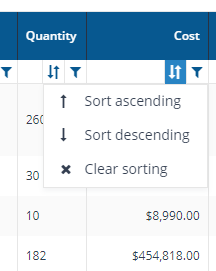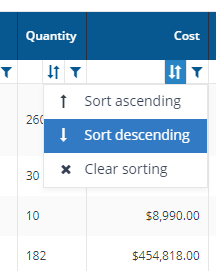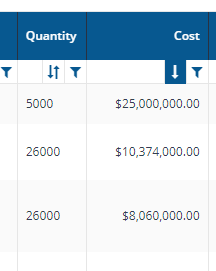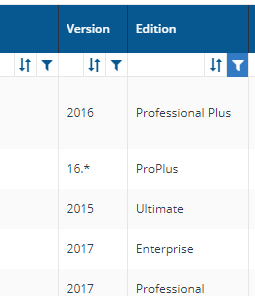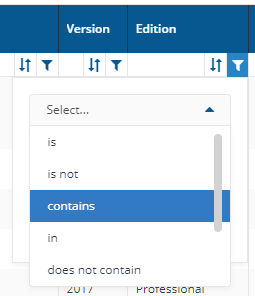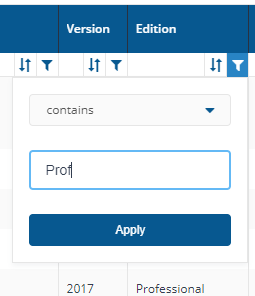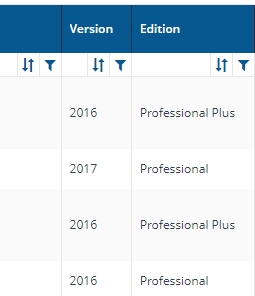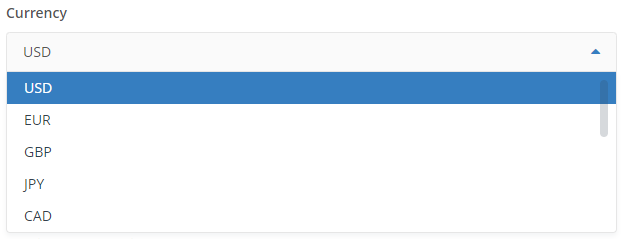Licenses / Maintenances page
A description of the fields on the Licenses / Maintenances page.
Here you can view, edit, copy, create, publish and delete License and Maintenance entitlements. You can also view any components related to a License or Maintenance and export all the entitlements in the selected repository to a TSV file. You get to this page by clicking the AppClarity→Entitlements→Licenses / Maintenances node in the navigation panel.
The fields on the Licenses / Maintenances page are:
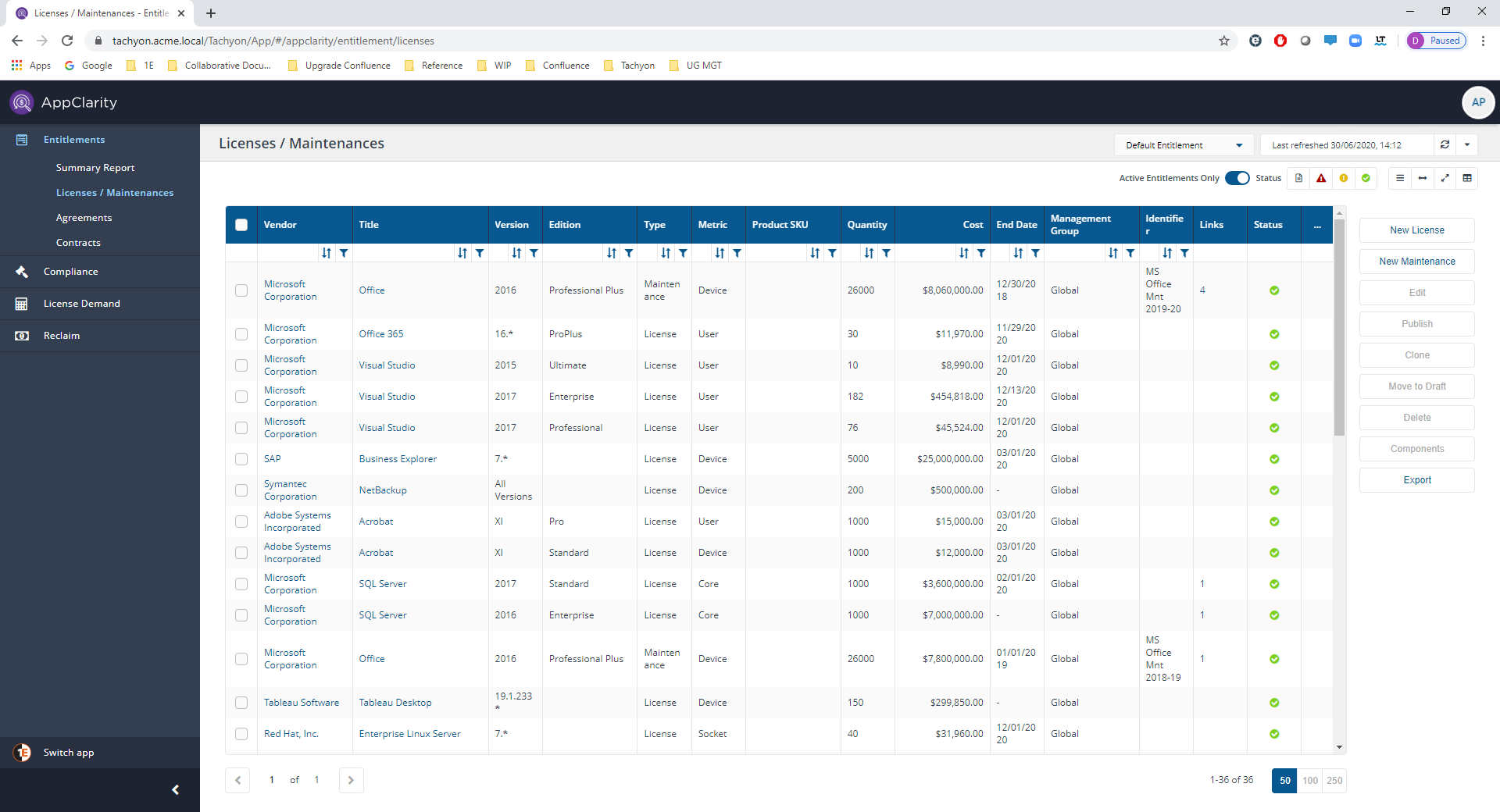
Field | Description | ||||||||||||||||||||||||||||||||||||||||||||||||||||||||||||||||||
|---|---|---|---|---|---|---|---|---|---|---|---|---|---|---|---|---|---|---|---|---|---|---|---|---|---|---|---|---|---|---|---|---|---|---|---|---|---|---|---|---|---|---|---|---|---|---|---|---|---|---|---|---|---|---|---|---|---|---|---|---|---|---|---|---|---|---|---|
This field lets you select the repository where the entitlements data displayed on the page comes from. By default this is set to Default Entitlements. If you have created your own entitlements repositories, click on the name to select any of these from the drop-down list. | |||||||||||||||||||||||||||||||||||||||||||||||||||||||||||||||||||
You can refresh reports from individual AppClarity screens as well as using the Settings App. Where this is available you can do this by using the refresh icon next to the Last Refreshed box:  | |||||||||||||||||||||||||||||||||||||||||||||||||||||||||||||||||||
The Active Entitlements only toggle adds a filter when it's turned on that filters the table to only display the entitlements that have been published and not the ones that are in draft. | |||||||||||||||||||||||||||||||||||||||||||||||||||||||||||||||||||
The Status filters are displayed in the top-right of the page and let you filter the table according to the status of the items in the table.  Clicking on an icon filters the table to display only items with that status, as described in the following table.
| |||||||||||||||||||||||||||||||||||||||||||||||||||||||||||||||||||
The following table describes the action buttons displayed on the Licenses / Maintenances page.
| |||||||||||||||||||||||||||||||||||||||||||||||||||||||||||||||||||
Where the column picker control is shown  To pick the displayed columns:
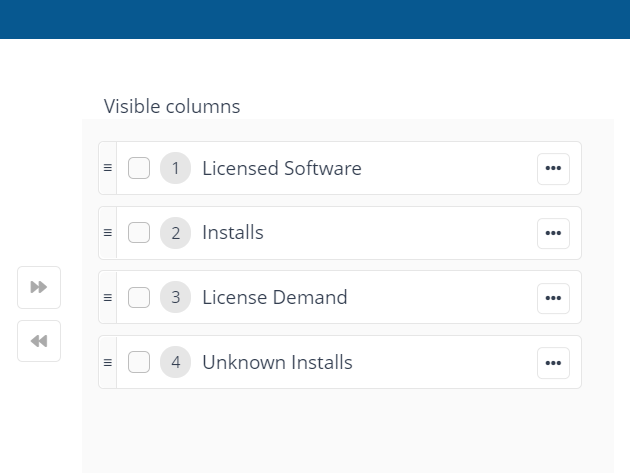

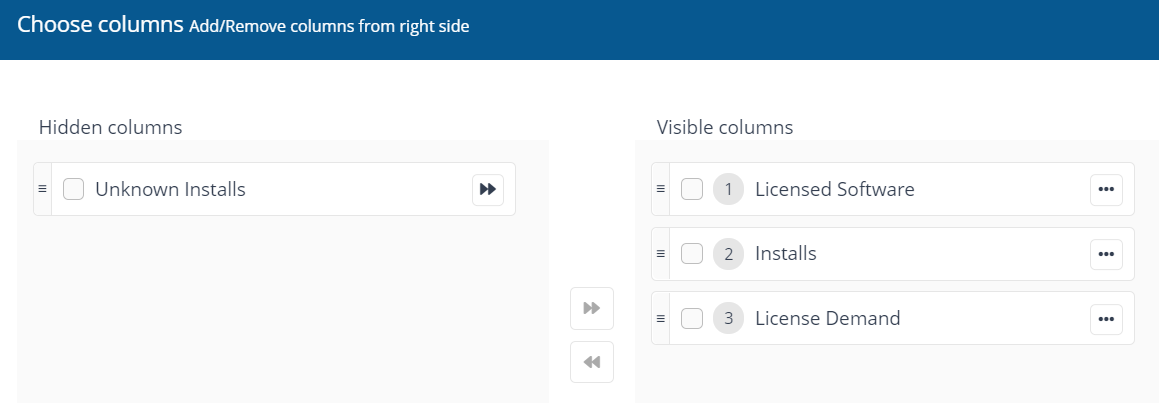

 | |||||||||||||||||||||||||||||||||||||||||||||||||||||||||||||||||||
The following table describes the columns displayed in the Licenses / Maintenances table:
The following column actions are available on some table columns.
|
New License page
A description of the fields in each section of the New License page. This also covers the Edit License page.
A license entitlement type in AppClarity specifies the rights and limitations of software and/or services that may be installed and/or used on an organizations computing devices. For example you could specify a license for Microsoft Visio 2016 and enable version downgrade rights to ensure that the license covers all versions up to 2016.
The sections on the New License or Edit License page are:
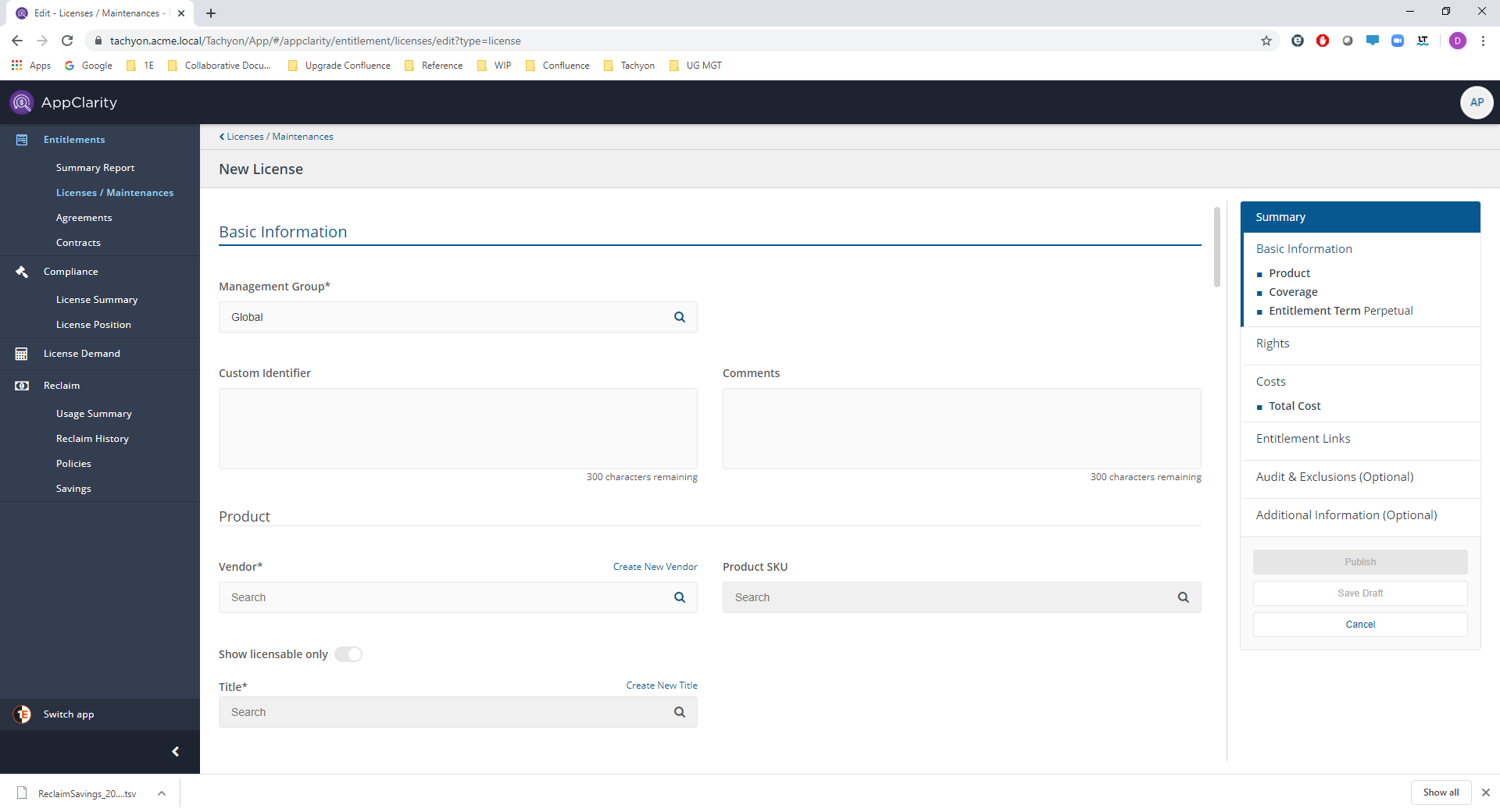
The Summary panel
The Summary panel on the right-hand side of the entitlement displays a summary of the settings that have been made in the entitlement so far. It's always visible on screen and can be used to navigate between the various sections of the entitlement.
The panel also contains the following buttons:
Button | Description |
|---|---|
Publish | Publishes the entitlement so it becomes active. |
Save Draft | Saves the current settings in the entitlement to a draft. This can be used to save edits if you are part way through creating or making changes to the entitlement. It can also be used to inactivate an entitlement by removing its published status. |
Cancel | Cancels the current edits and closes the page. |
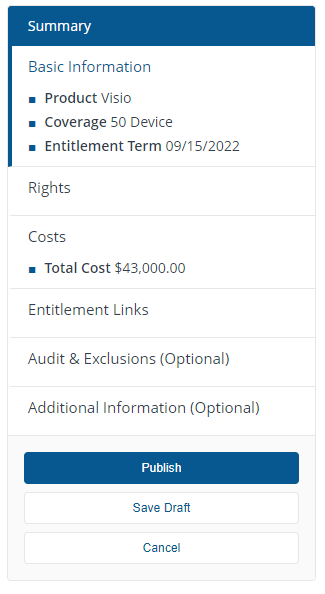
Basic Information
This section deals with the basic information for the entitlement, such as details of the product, the coverage and term of the entitlement.

Field | Details |
|---|---|
Management Group* | Here you can associate the entitlement with Management Group of your choice. |
Custom Identifier | An optional field. You can specify any alpha-numeric value to help identify the entitlement in theDraftandPublishedpages and when linking to other entitlements. |
Comments | Enter text here to store any comments you have related to the entitlement. |
Product
This sub-section defines the product covered by the entitlement.
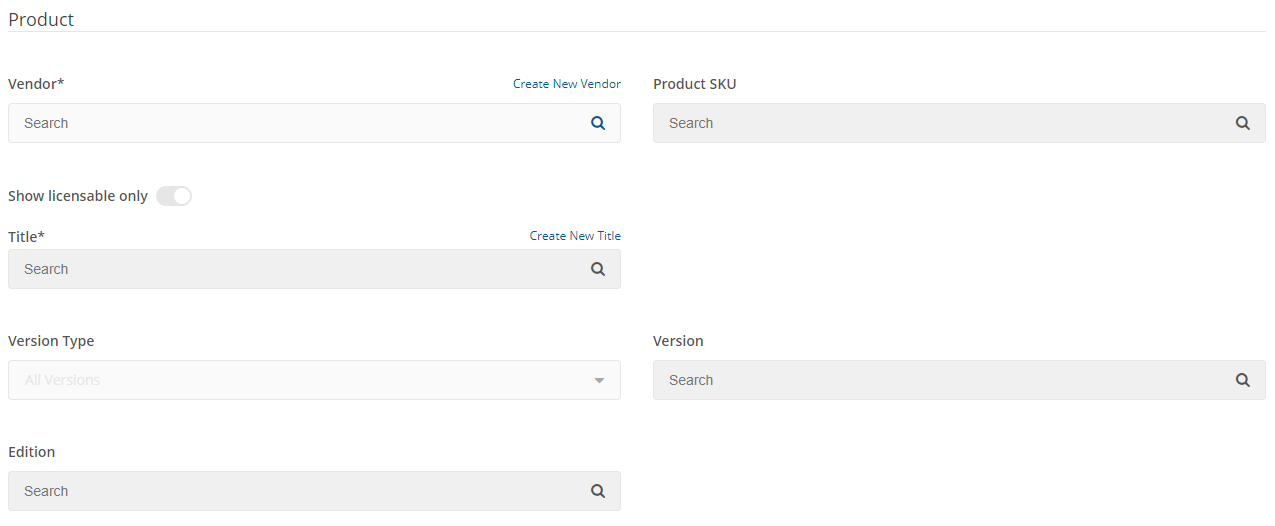
Field | Details |
|---|---|
Vendor* | Defines the vendor of the product the license will apply to. The vendor part of the vendor, title, version and edition for a product. This must be filled out before any other fields. Suggested suitable vendors that match your text are displayed as you type into the field, which you can select to auto-complete the entry. |
Product SKU | Suggested matching SKU are displayed as you type into the field, which you can select to auto-complete the entry. When you select a SKU other fields in the license will be automatically prefilled. For example, selecting the SKU for a particular edition of Microsoft Office 365 may set the License Type to Subscription, the Product title to Office 365 and the Edition to ProPlus. These fields will then be fixed as they are derived from the SKU and not entered by hand. |
Show licensable only | This toggle, which is on by default, sets whether the matches from 1E Catalog are filtered to show only products that are marked as licensable - and therefore appropriate for entitlements. You can flip this to off, if the product you are looking for is not visible and you're not sure if it's licensable or not, to see the unfiltered list of product related information from 1E Catalog. |
Title* | Defines the title of the product the license will apply to. This is a mandatory field. The title part of the vendor, title, version and edition for a product. Suggested suitable titles from the selected vendor that match your text are displayed as you type into the field, which you can select to auto-complete the entry. |
Version Type | All Versions, Dot Format,or Colloquial. By default this is set toAll Versions. |
Version | Defines the version of the product the license will apply to. The version part of the vendor, title, version and edition for a product. The Version format is dependent on the chosen Version Type. This field is disabled for a Version Type of All Versions. |
Edition | Defines the edition of the product the license will apply to. The edition part of the vendor, title, version and edition for a product. Suggested suitable editions for the selected vendor and title that match your text are displayed as you type into the field, which you can select to auto-complete the entry. |
Coverage
This sub-section defines the coverage details for the entitlement, such as: the metric that will be used for the entitlement and the number of installations the entitlement covers, i.e. whether the entitlement is unlimited or defined by a specific quantity of units.

Field | Details | ||||||||||||||
|---|---|---|---|---|---|---|---|---|---|---|---|---|---|---|---|
Metric | The metric type for a license or maintenance entitlement. This may be one of:
The Metric works with the Quantity field to determine how licenses are applied. | ||||||||||||||
Other metric | This field is enabled if the Metric field is set to Other and allows you to specify an entitlement metric that is not covered by default in AppClarity. This field is only enabled if Other is selected in the Metric Type for entitlements and allows you to enter a metric that is not covered by the basic Metric Type options. | ||||||||||||||
Unlimited | If you set theUnlimitedtoggle to on, this entitlement will cover all installations and theQuantityand Units fields will be disabled. | ||||||||||||||
Quantity | Sets the number of licenses bought for this entitlement. Only enabled if the Unlimited toggle is set to off, in which case this field is also mandatory. | ||||||||||||||
Units | Sets the number of units per licenses purchased. Only enabled if theUnlimitedtoggle is set to off, in which case this field is also mandatory. | ||||||||||||||
Total | The total number of licenses, which is the Quantity value times the Units value. AppClarity will count each unit in the Total field against a single unit of the given Metric type. So if the Metric type is Device and the Total calculates to 50 this will count against 50 devices. For an SQL Server Enterprise example the Metric type would be Core so this will count against 50 cores. |
Entitlement Term
This sub-section defines the type and length details for the entitlement, such as: the type (perpetual or subscription), the start date and, if the type is subscription, the duration and end date.

Field | Details |
|---|---|
Entitlement Type | For License entitlements this can be set to Perpetual or Subscription. By default this is set to Perpetual. For Maintenance entitlements this can only be set to Subscription. |
Start Date* | When the entitlement starts applying. This defaults to the date the entitlement was created. |
Duration* | The Duration and End Date fields are only enabled for Subscription entitlements. If you set the Duration the End Date is calculated. If you set the End Date the Duration is calculated. These fields determine how long the entitlement is applicable for after start date. The Duration is set in terms of months and determines the number of months the entitlement will be valid for. |
End Date* | The Duration and End Date fields are only enabled for Subscription entitlements. If you set the Duration the End Date is calculated. If you set the End Date the Duration is calculated. These fields determine how long the entitlement is applicable for after start date. The End Date indicates the last date the entitlement will be valid until and is set using a date picker. |
Rights
This section lets you control how the entitlement applies to existing versions of the product it's related to.
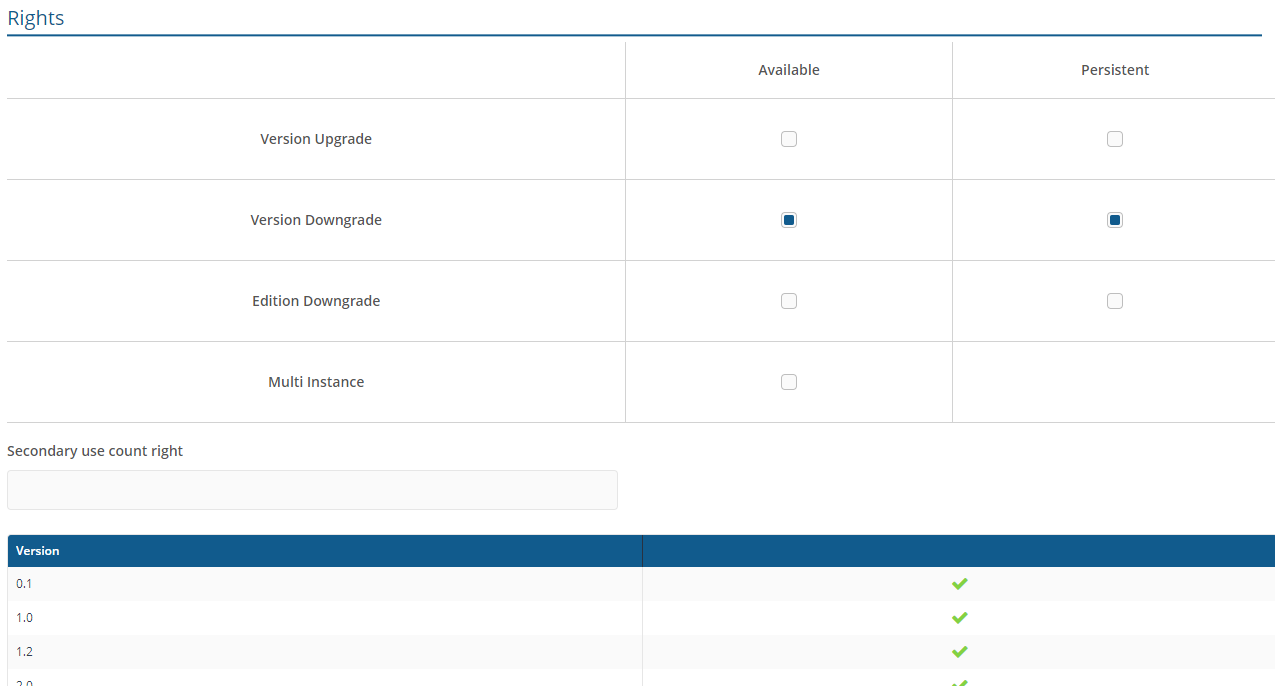
Field | Details |
|---|---|
Version Upgrade | Rights to check if the entitlement is also applicable on higher versions of selected version |
Version Downgrade | Rights to check if the entitlement is also applicable on lower versions of selected version. By default it is true |
Edition Downgrade | Rights to check if the entitlement is also applicable on lower editions of selected edition |
Multi Instance | Rights to check if the same license is also applicable on multiple installations on same device |
Secondary use count right | The available count of secondary uses |
Versions covered | The table below the fields shows the overall versions and editions covered by the entitlement based on the selected rights. |
Costs
This section lets you control how the entitlement is costed and how it can be considered within the overall spend.

Field | Details | |
|---|---|---|
Currency | The currency applied to the entitlement. Clicking on the Currency field displays a list of currencies to choose from.
| |
Payment Frequency | OnceOff, Monthly, Quarterly, Yearly. The default is OnceOff. | |
Unit Cost | The cost of the licence per unit, combined with the Quantity and Unit Cost Type values to calculate the license cost. | |
License Cost | This is calculated based on value filed in the Quantity, Unit Cost and Payment Frequency. This value only displays the cost and cannot be edited directly. |
Entitlement Links
This section lets you create links between your entitlements. If you are creating a new entitlement this section will initially look like this:

After you have saved the entitlement this section provides an interface for linking it to other entitlements:
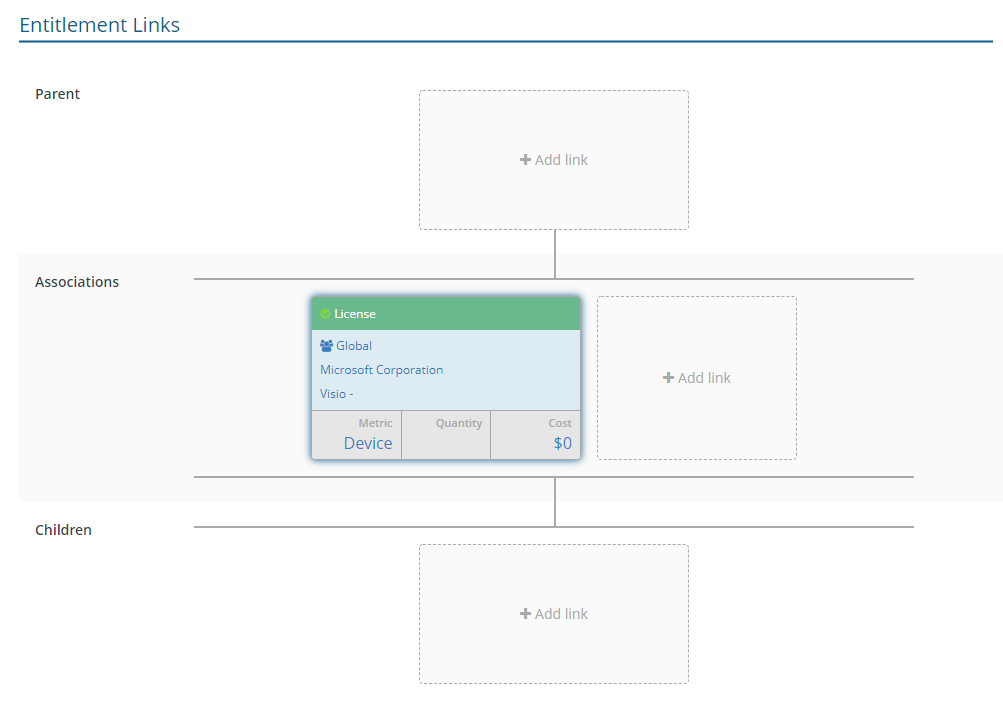
There are three sub-sections:
Parent
Here you can link parent licenses or agreements. Clicking on the +Add link area displays the Add Parent popup.
Select License or Agreement to add that type of link, a list of entitlements of the selected type will be displayed. Click on any of these and a green check mark will appear to indicate the selected parent, you can only select one. Once you've made your choice click the Add button to link the checked parent.
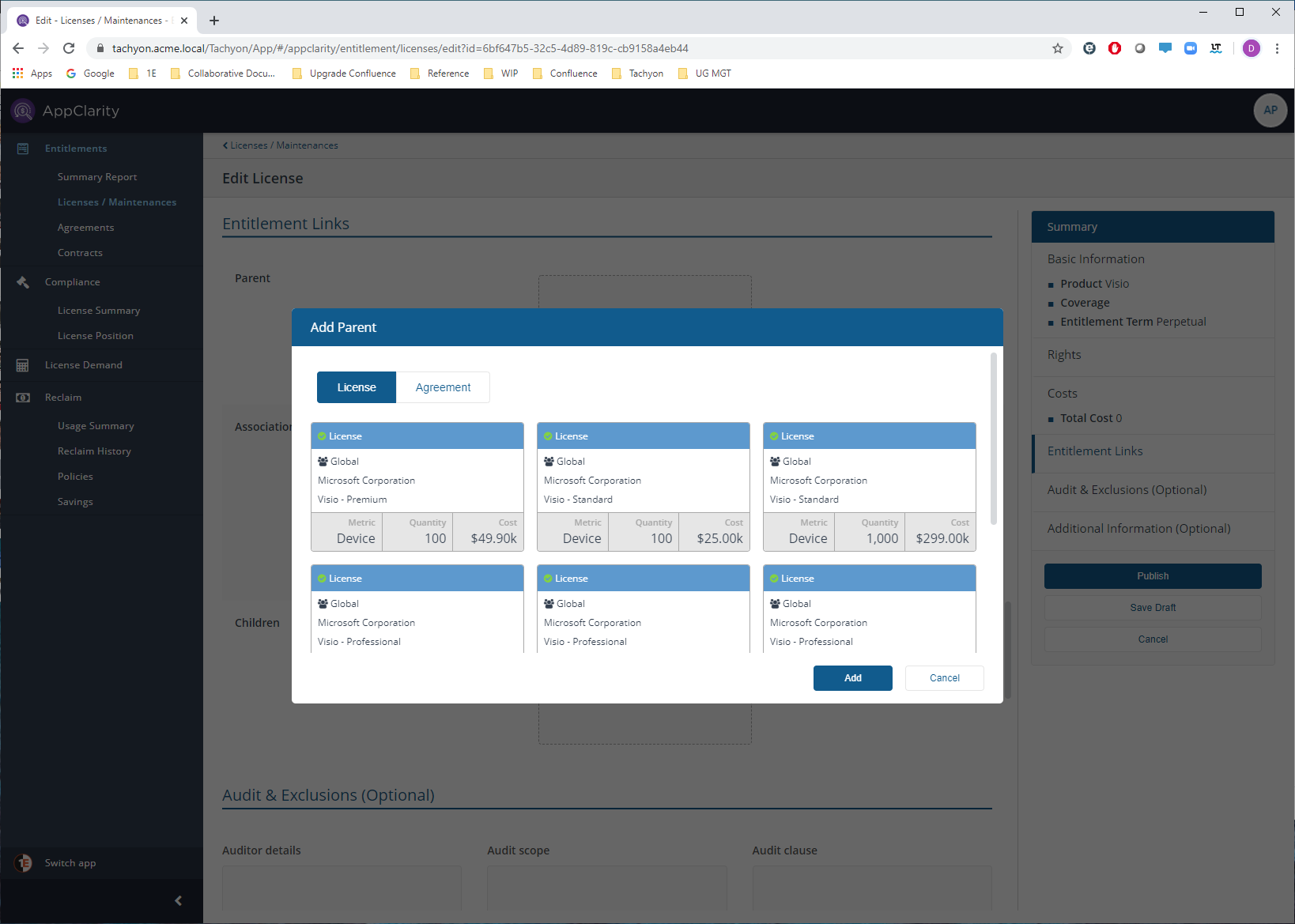
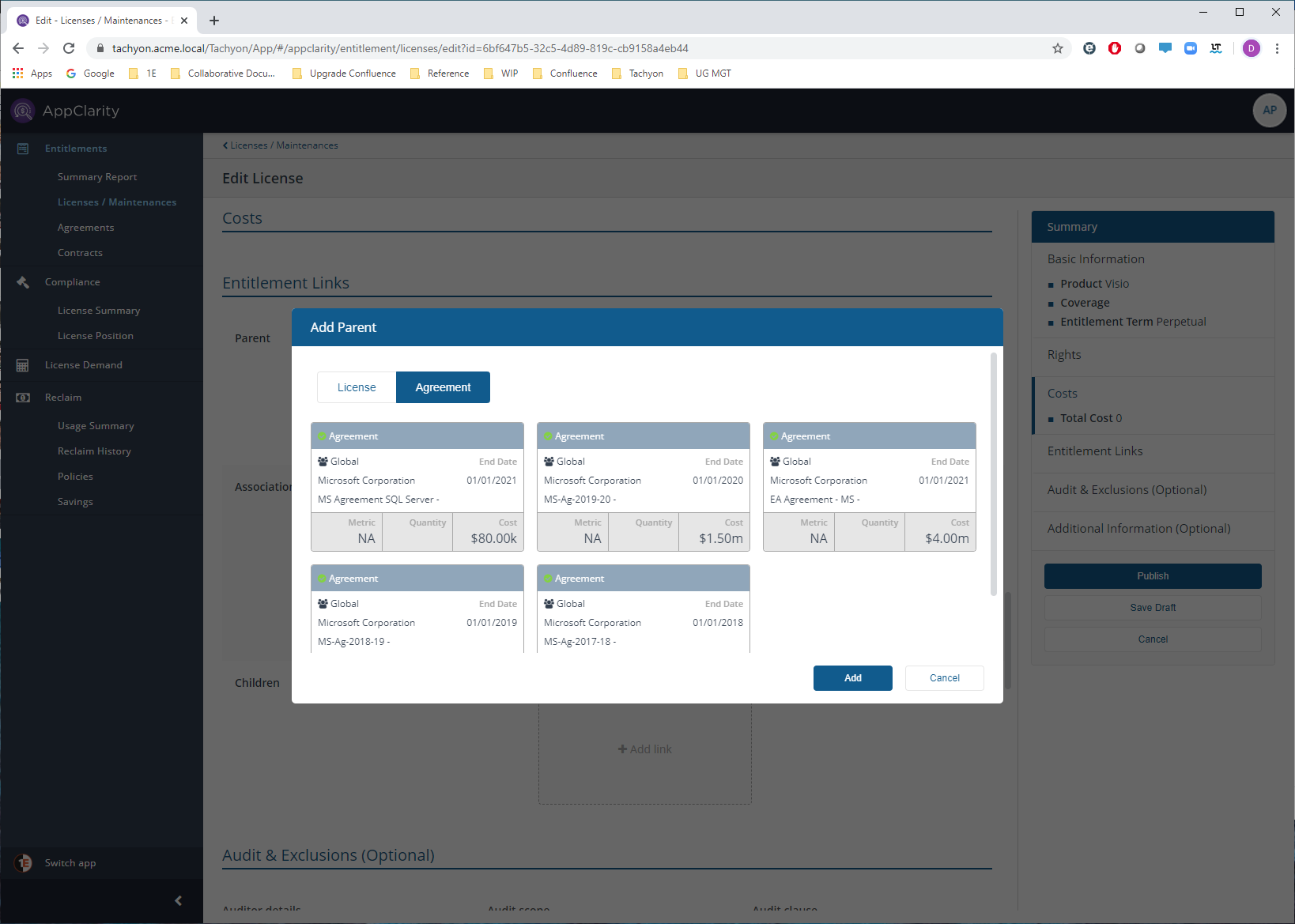
Associations
Here you can link contracts. Clicking on the +Add link area displays the Add Contract popup.
A list of contracts will be displayed. Click on any of these and a green check mark will appear to indicate the selected contract, you can select more than one contract to link. Once you've made your choice click the Add button to link the checked contract(s).
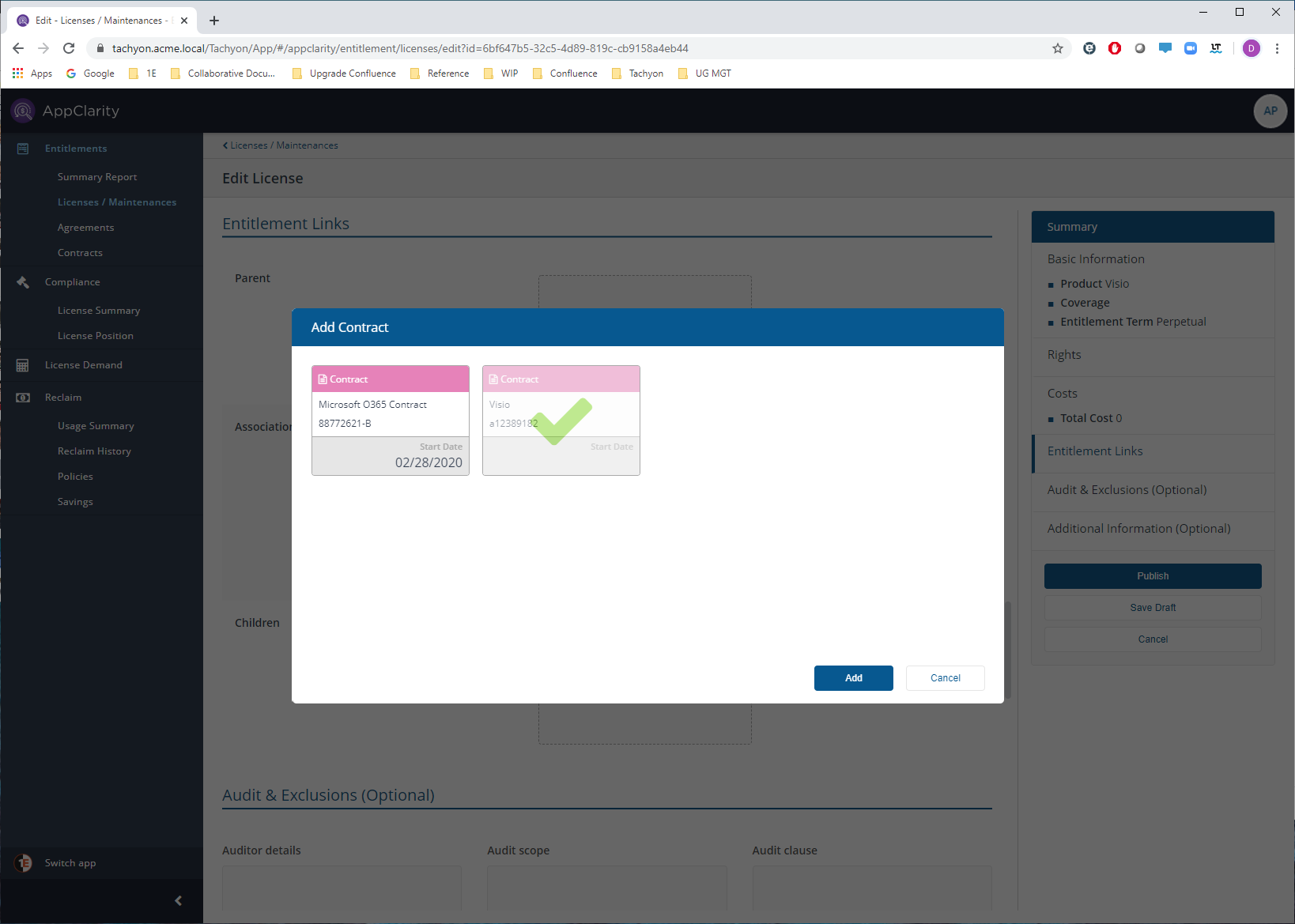
Children
Here you can link child licenses or maintenances. Clicking on the +Add link area displays the Add Child popup.
Select License or Agreement to add that type of link, a list of entitlements of the selected type will be displayed. Click on any of these and a green check mark will appear to indicate the selected child - you can select more than one. Once you've made your choice click the Add button to link the checked children.
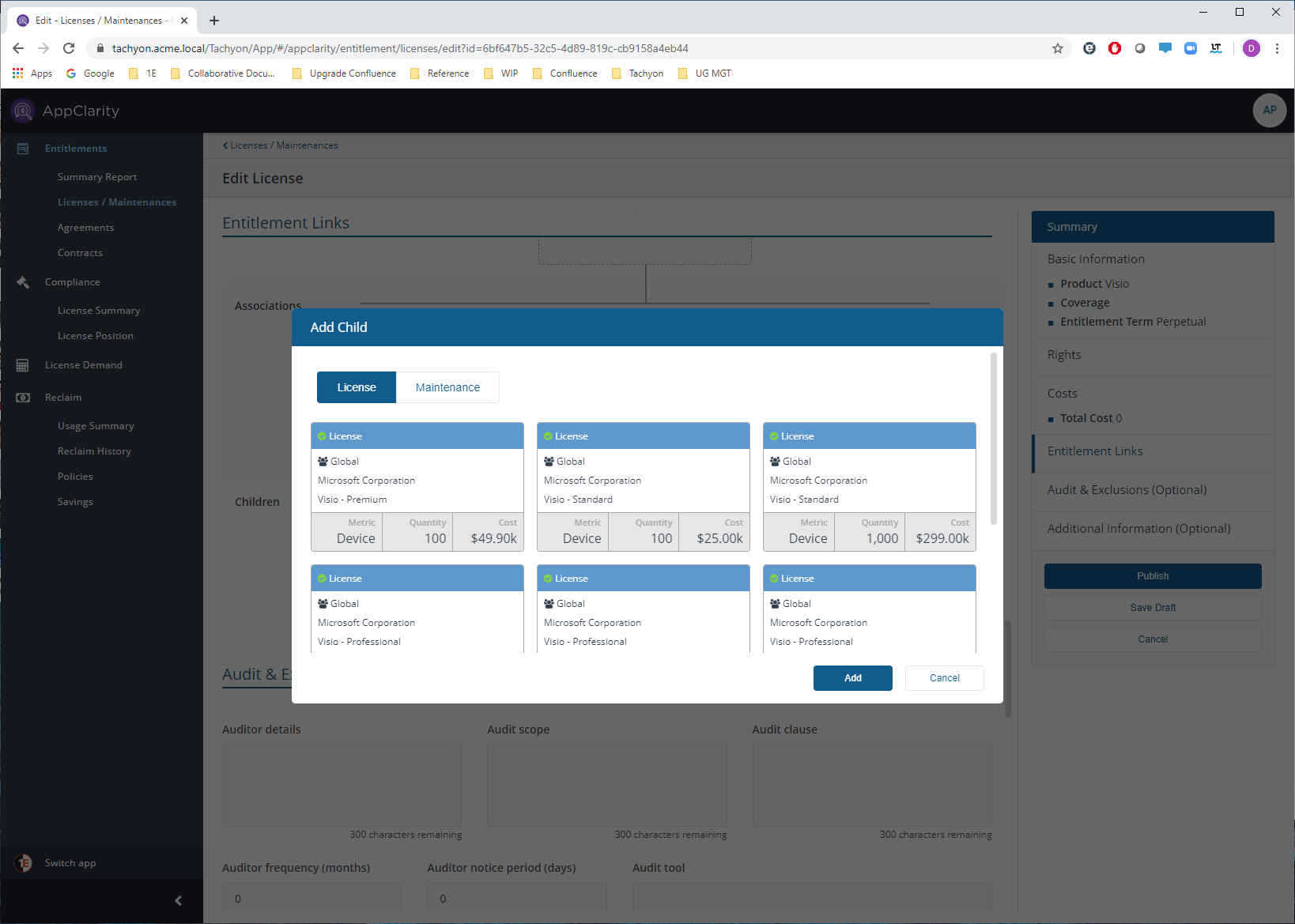
Audit & Exclusions (Optional)
This section lets you control how the entitlement is audited.
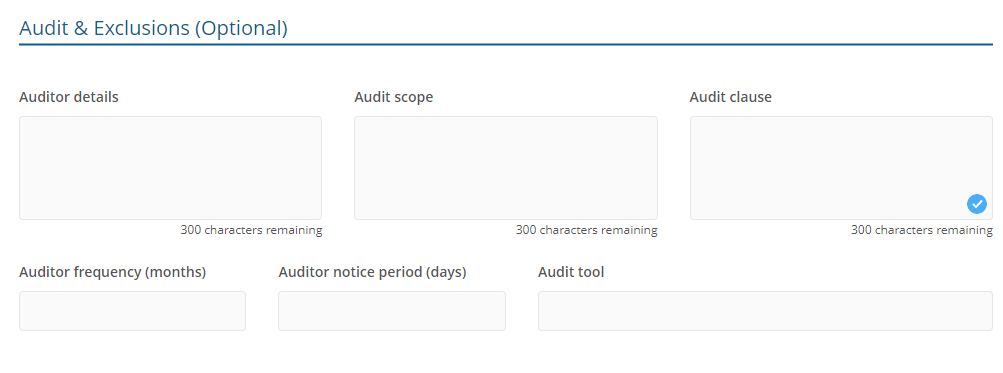
Field | Details |
|---|---|
Auditor Details | Organizations that are allowed to perform the audit including (if appropriate), the licensor organization and any third-party organizations, according to what was agreed in the contract. |
Audit Scope | Defines what part of the software customer organization is allowed to be audited. |
Audit Clause | Provides additional information on what could trigger the audit. |
Auditor Frequency | Definition of the highest agreed frequency of the audit expressed in months. |
Auditor Notice period | Notice period in days. |
Audit Tool | Name of the tool(s) which are approved for use in the audit. |
Additional information (Optional)
This section lets you enter additional information related to the entitlement that may come from a Vendor agreement or contract.
Sub-Section | Field | Field Details |
|---|---|---|
Business Unit | Specifies the Business Unit the agreement will be applied to. This may correspond to your management groups, depending on how you have those configured. | |
Sponsor | Name of the person who manages the budget associated with an agreement (this field is likely to be used only on agreements, but could be extended to other entitlements) | |
Invoice | Number | The invoice number, usually specified in the customer contract. |
Line Item Number | This optionally identifies the line number (if provided) on the customer contract that pertains to the invoice. | |
Date | The date for the invoice. | |
Purchase Order | Number | The purchase order number, usually specified in the customer contract. |
Line Item Number | This optionally identifies the line number (if provided) on the customer contract that pertains to the purchase order. | |
Date | The date for the purchase order. | |
Direct Supplier | Number | The number that identifies the direct supplier. For example, in some organizations this may be the same as the contract number. |
Line Item Number | This optionally identifies the line number (if provided) on the contract that pertains to the direct supplier. | |
Date | The date for the contract. | |
Internal Order | Number | The ITARS or similar internal identifier for the order as specified in the customer contract. |
Line Item Number | This optionally identifies the line number(if provided)on the contract that pertains to the internal order. | |
Date | The date for the contract. | |
Licensor Details | Number | The number (or name) of the licensor, could be the vendor or a VAR. |
Line Item Number | This is intended as a reference to a licensor source other than an invoice, e.g. to an on-line portal of license purchases. | |
Date | The date for the contract. | |
FOSS Details | IsFoss | This value is true only if the granted rights fulfill the requirements of both definition of the Free software maintained by the Free Software Foundation. |
Copy Left | This value provides information on whether derivative works (which are always allowed for open source software) are themselves required to be open source software. There are three allowed values: “strong” means that all kinds of derivative works are required to be open source software themselves, “no” means that for all kinds of derivative works, it is allowed to distribute the derivative work as proprietary software. The intermediate value of “weak” means that there are some restrictions and the details are to be checked in the license. | |
Trademark restrictions | FOSS trademark restrictions. |
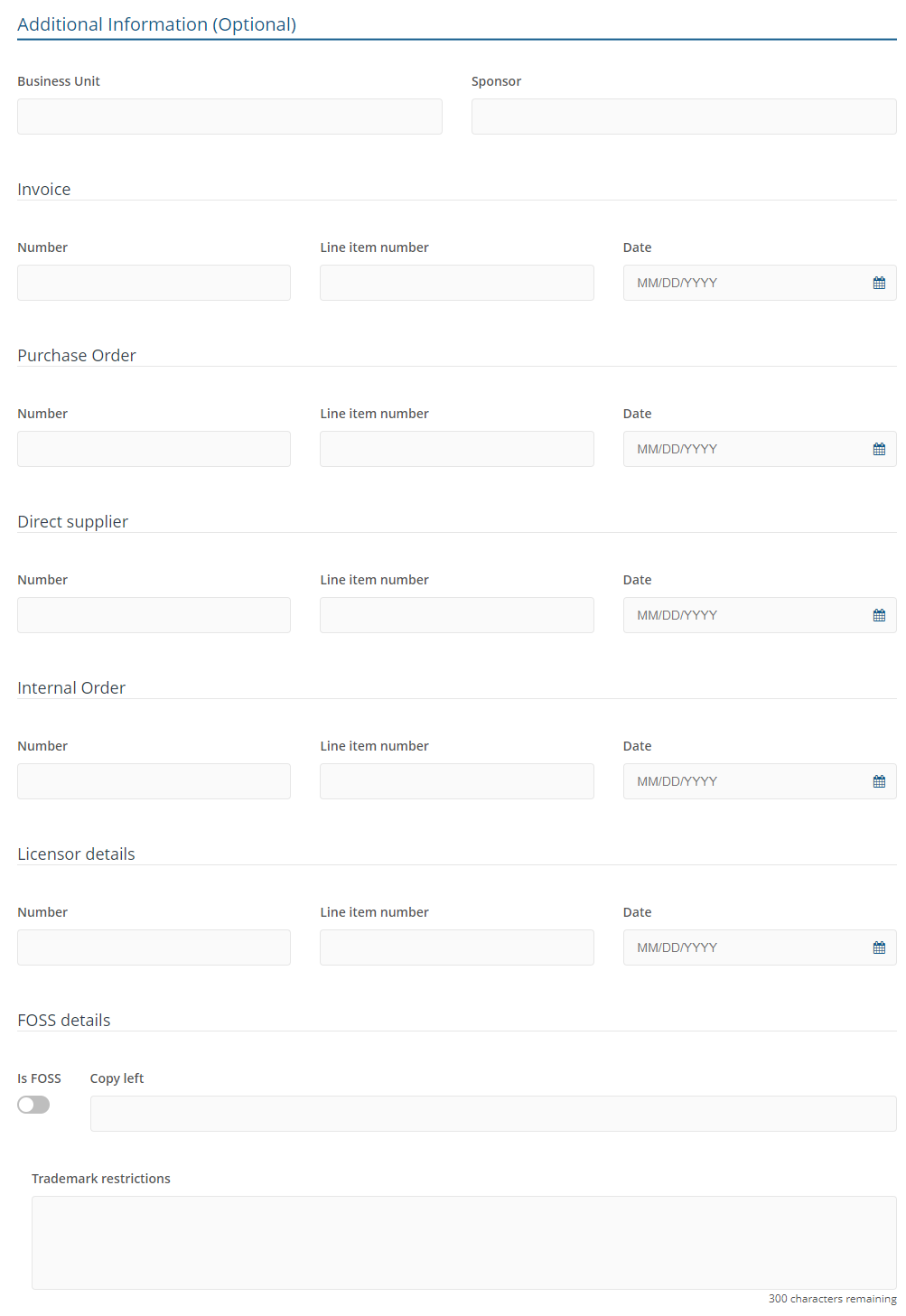
New Maintenance page
A description of the fields in each section of the Create Maintenance page. This also covers the Edit Maintenance page.
A Maintenance entitlement type in AppClarity specifies the rights and limitations for an organization to install and/or use updated versions of software defined in a license. For example you could specify a maintenance entitlement for Microsoft Visio 2016 to cover all new versions from the current date for the next 3 years.
The sections on the New Maintenance or Edit Maintenance page are:

The Summary panel
The Summary panel on the right-hand side of the entitlement displays a summary of the settings that have been made in the entitlement so far. It's always visible on screen and can be used to navigate between the various sections of the entitlement.
The panel also contains the following buttons:
Button | Description |
|---|---|
Publish | Publishes the entitlement so it becomes active. |
Save Draft | Saves the current settings in the entitlement to a draft. This can be used to save edits if you are part way through creating or making changes to the entitlement. It can also be used to inactivate an entitlement by removing its published status. |
Cancel | Cancels the current edits and closes the page. |
Basic Information
This section deals with the basic information for the entitlement, such as details of the product, the coverage and term of the entitlement.

Field | Details |
|---|---|
Management Group* | Here you can associate the entitlement with Management Group of your choice. |
Custom Identifier | An optional field. You can specify any alpha-numeric value to help identify the entitlement in theDraftandPublishedpages and when linking to other entitlements. |
Comments | Enter text here to store any comments you have related to the entitlement. |
Product
This sub-section defines the product covered by the entitlement.

Field | Details |
|---|---|
Vendor* | Defines the vendor of the product the license will apply to.The vendor part of the vendor, title, version and edition for a product. This must be filled out before any other fields. Suggested suitable vendors that match your text are displayed as you type into the field, which you can select to auto-complete the entry. |
Product SKU | Suggested matching SKU are displayed as you type into the field, which you can select to auto-complete the entry. When you select a SKU other fields in the license will be automatically prefilled. For example, selecting the SKU for a particular edition of Microsoft Office 365 may set the License Type to Subscription, the Product title to Office 365 and the Edition to ProPlus. These fields will then be fixed as they are derived from the SKU and not entered by hand. |
Show licensable only | This toggle, which is on by default, sets whether the matches from 1E Catalog are filtered to show only products that are marked as licensable - and therefore appropriate for entitlements. You can flip this to off, if the product you are looking for is not visible and you're not sure if it's licensable or not, to see the unfiltered list of product related information from 1E Catalog. |
Title* | Defines the title of the product the license will apply to. This is a mandatory field.The title part of the vendor, title, version and edition for a product. Suggested suitable titles from the selected vendor that match your text are displayed as you type into the field, which you can select to auto-complete the entry. |
Version Type | All Versions, Dot Format,or Colloquial. By default this is set toAll Versions. |
Version | Defines the version of the product the license will apply to.The version part of the vendor, title, version and edition for a product. The Version format is dependent on the chosen Version Type. This field is disabled for a Version Type of All Versions. |
Edition | Defines the edition of the product the license will apply to.The edition part of the vendor, title, version and edition for a product. Suggested suitable editions for the selected vendor and title that match your text are displayed as you type into the field, which you can select to auto-complete the entry. |
Coverage
This sub-section defines the coverage details for the entitlement, such as: the metric that will be used for the entitlement and the number of installations the entitlement covers, i.e. whether the entitlement is unlimited or defined by a specific quantity of units.

Field | Details | ||||||||||||||
|---|---|---|---|---|---|---|---|---|---|---|---|---|---|---|---|
Metric | The metric type for a license or maintenance entitlement. This may be one of:
The Metric works with the Quantity field to determine how licenses are applied. | ||||||||||||||
Other metric | This field is enabled if the Metric field is set to Other and allows you to specify an entitlement metric that is not covered by default in AppClarity. This field is only enabled if Other is selected in the Metric Type for entitlements and allows you to enter a metric that is not covered by the basic Metric Type options. | ||||||||||||||
Unlimited | If you set theUnlimitedtoggle to on, this entitlement will cover all installations and theQuantityand Units fields will be disabled. | ||||||||||||||
Quantity | Sets the number of licenses bought for this entitlement. Only enabled if the Unlimited toggle is set to off, in which case this field is also mandatory. | ||||||||||||||
Units | Sets the number of units per licenses purchased. Only enabled if theUnlimitedtoggle is set to off, in which case this field is also mandatory. | ||||||||||||||
Total | The total number of licenses, which is the Quantity value times the Units value. AppClarity will count each unit in the Total field against a single unit of the given Metric type. So if the Metric type is Device and the Total calculates to 50 this will count against 50 devices. For an SQL Server Enterprise example the Metric type would be Core so this will count against 50 cores. |
Entitlement Term
This sub-section defines the type and length details for the entitlement, such as: the start date and the duration and end date.

Field | Details |
|---|---|
Entitlement Type | For License entitlements this can be set to Perpetual or Subscription. By default this is set to Perpetual. For Maintenance entitlements this can only be set to Subscription. |
Start Date* | When the entitlement starts applying. This defaults to the date the entitlement was created. |
Duration* | The Duration and End Date fields are only enabled for Subscription entitlements. If you set the Duration the End Date is calculated. If you set the End Date the Duration is calculated. These fields determine how long the entitlement is applicable for after start date. The Duration is set in terms of months and determines the number of months the entitlement will be valid for. |
End Date* | The Duration and End Date fields are only enabled for Subscription entitlements. If you set the Duration the End Date is calculated. If you set the End Date the Duration is calculated. These fields determine how long the entitlement is applicable for after start date. The End Date indicates the last date the entitlement will be valid until and is set using a date picker. |
Rights
This section lets you control how the entitlement applies to existing versions of the product it's related to.

Field | Details |
|---|---|
Version Upgrade | Rights to check if the entitlement is also applicable on higher versions of selected version |
Version Downgrade | Rights to check if the entitlement is also applicable on lower versions of selected version. By default it is true |
Edition Downgrade | Rights to check if the entitlement is also applicable on lower editions of selected edition |
Multi Instance | Rights to check if the same license is also applicable on multiple installations on same device |
Secondary use count right | The available count of secondary uses |
Versions covered | The table below the fields shows the overall versions and editions covered by the entitlement based on the selected rights. |
Costs
This section lets you control how the entitlement is costed and how it can be considered within the overall spend.

Field | Details | |
|---|---|---|
Currency | The currency applied to the entitlement. Clicking on the Currency field displays a list of currencies to choose from.
| |
Payment Frequency | OnceOff, Monthly, Quarterly, Yearly. The default is OnceOff. | |
Unit Cost | The cost of the licence per unit, combined with the Quantity and Unit Cost Type values to calculate the license cost. | |
License Cost | This is calculated based on value filed in the Quantity, Unit Cost and Payment Frequency. This value only displays the cost and cannot be edited directly. |
Entitlement Links
This section lets you create links between your entitlements. If you are creating a new entitlement this section will initially look like this:

After you have saved the entitlement this section provides an interface for linking it to other entitlements:
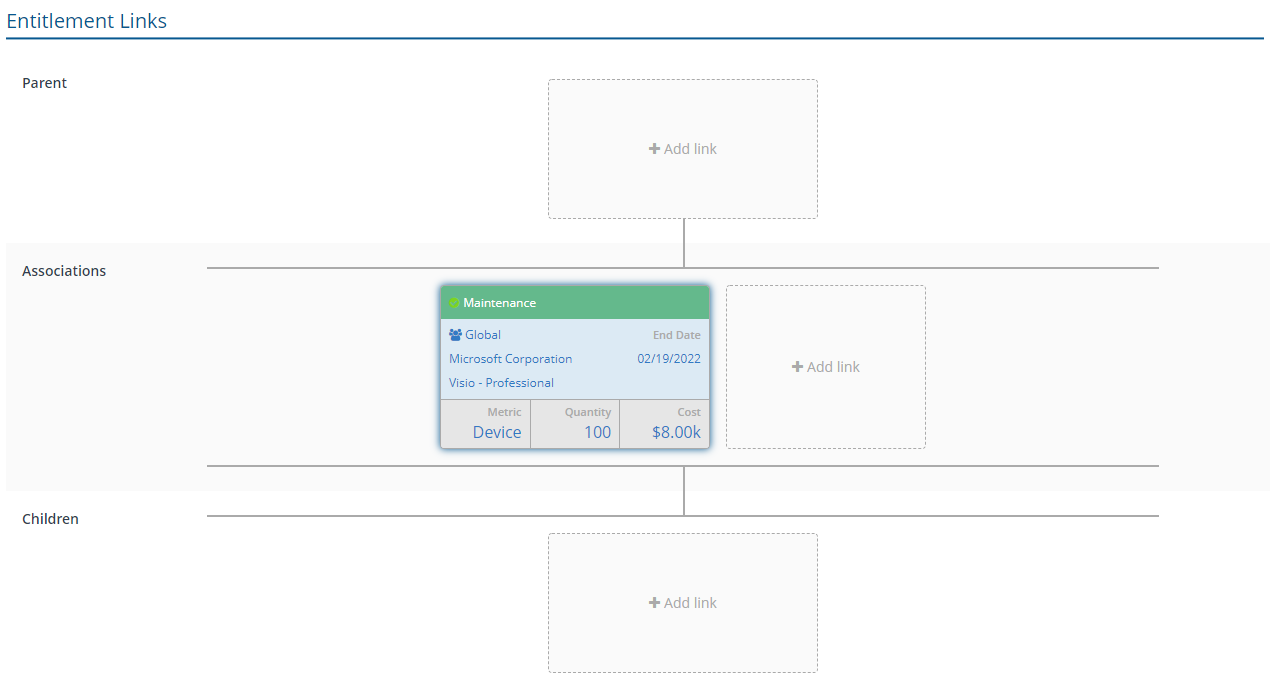
There are three sub-sections:
Parent
Here you can link a parent license, agreement or maintenance. Clicking on the +Add link area displays the Add Parent popup.
Select License, Agreement or Maintenance to add that type of link - a list of entitlements of the selected type will be displayed. Click on any of these and a green check mark will appear to indicate the selected parent, you can only select one. Once you've made your choice click the Add button to link the checked parent.
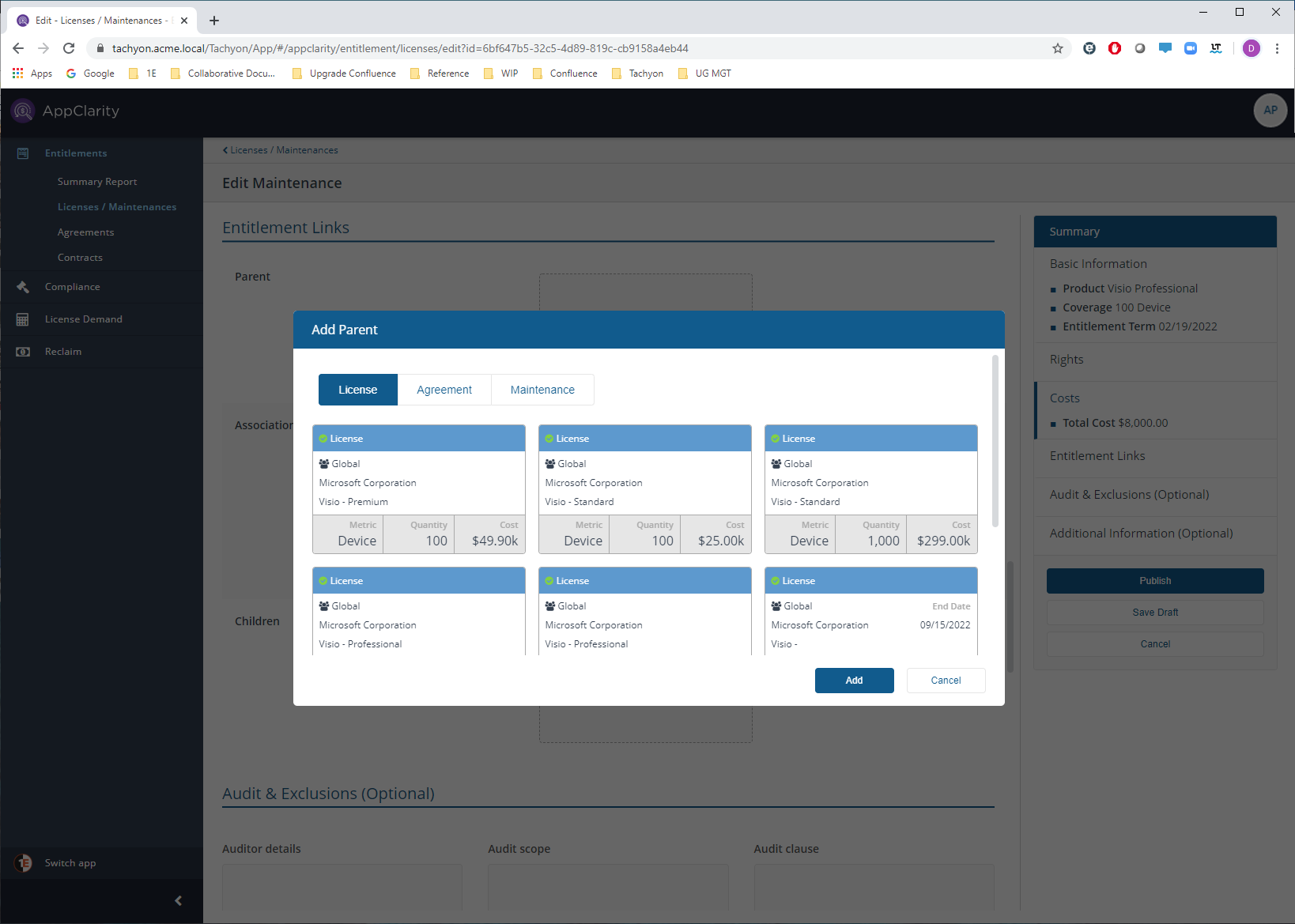
Associations
Here you can link contracts. Clicking on the +Add link area displays the Add Contract popup.
A list of contracts will be displayed. Click on any of these and a green check mark will appear to indicate the selected contract, you can select more than one contract to link. Once you've made your choice click the Add button to link the checked contract(s).
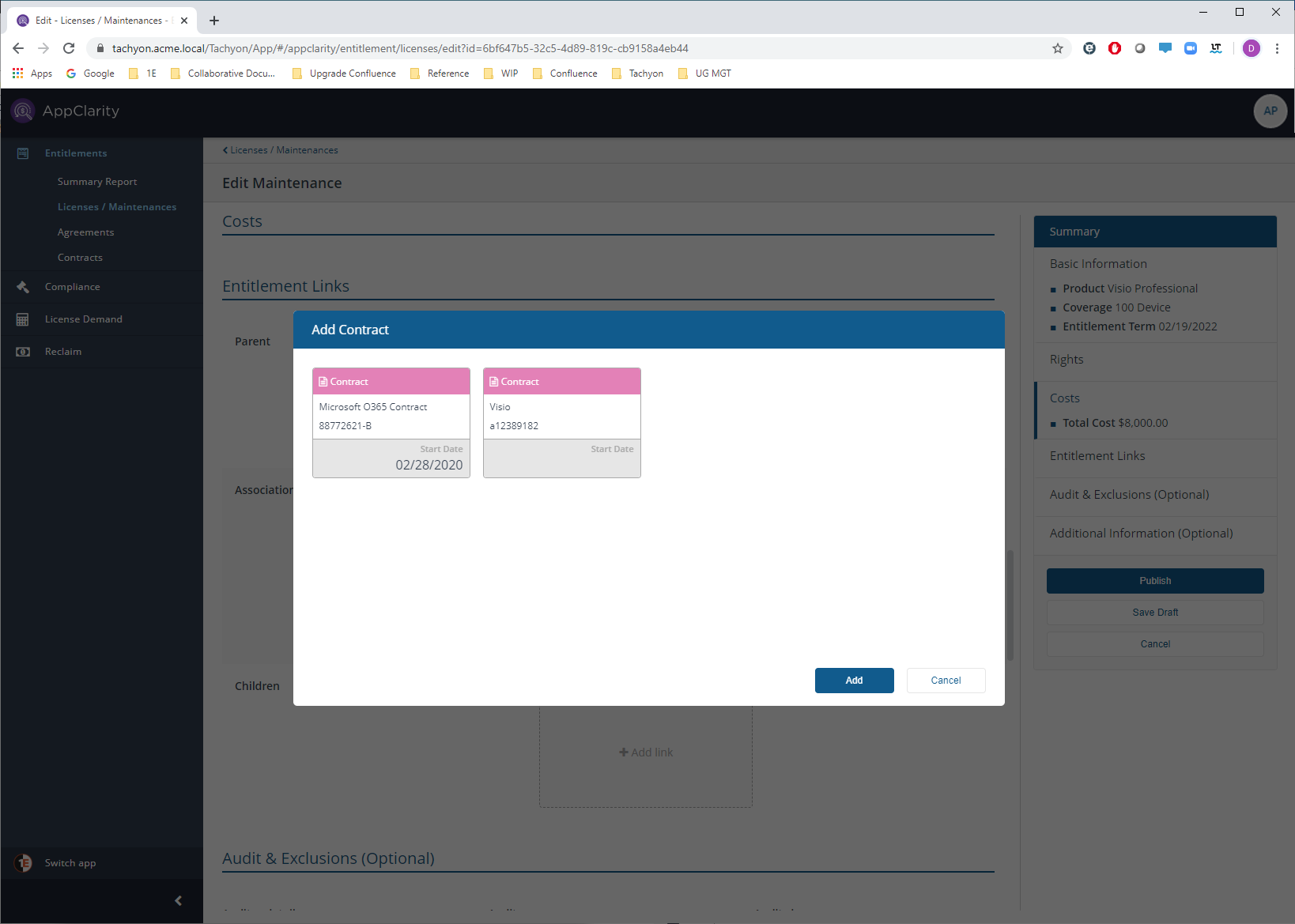
Children
Here you can link child maintenances. Clicking on the +Add link area displays the Add Child popup.
A list of maintenance entitlements is displayed. Click on any of these and a green check mark will appear to indicate the selected child - you can select more than one child. Once you've made your choice click the Add button to link the checked children.
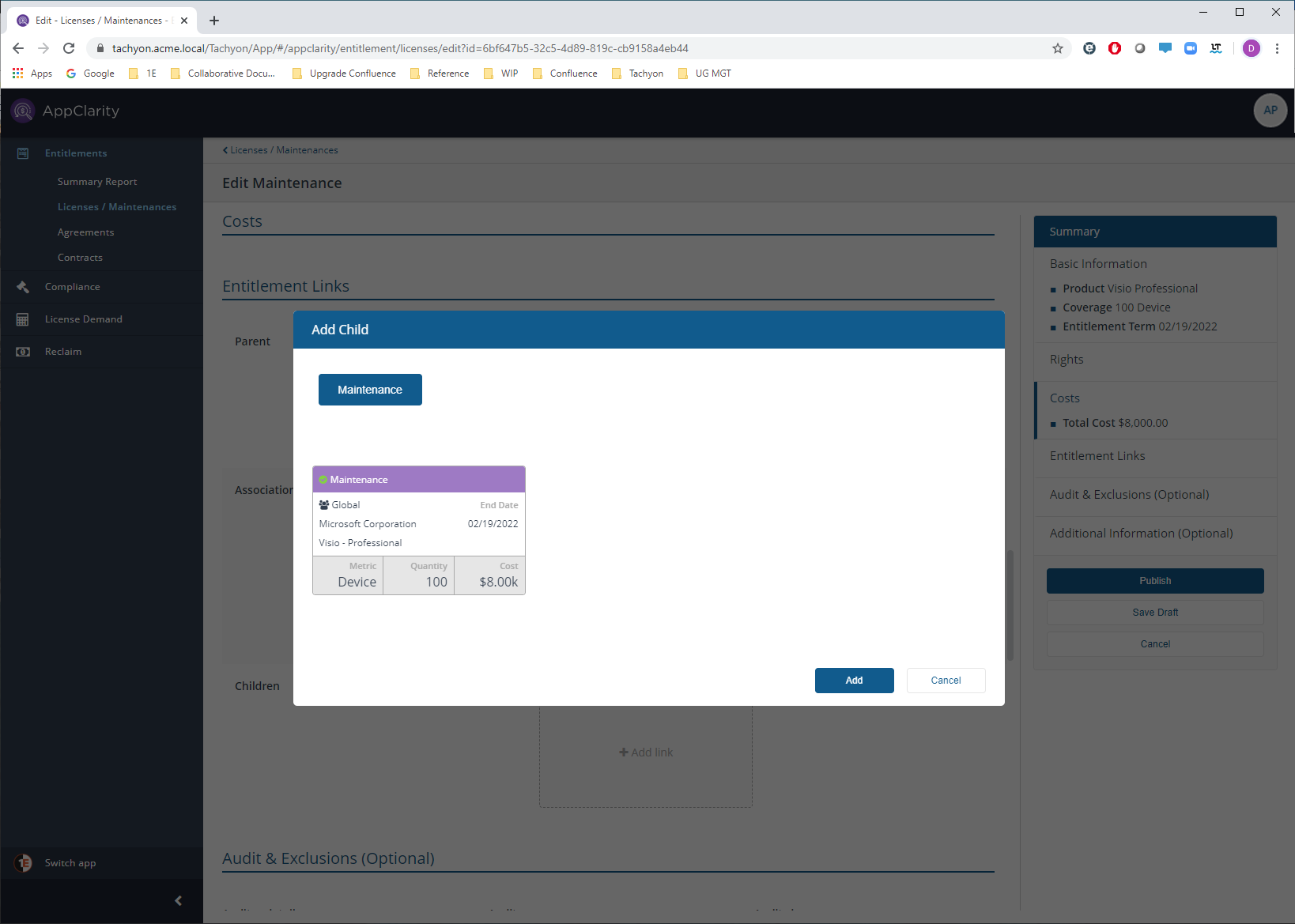
Audit & Exclusions (Optional)
This section lets you control how the entitlement is audited.

Field | Details |
|---|---|
Auditor Details | Organizations that are allowed to perform the audit including (if appropriate), the licensor organization and any third-party organizations, according to what was agreed in the contract. |
Audit Scope | Defines what part of the software customer organization is allowed to be audited. |
Audit Clause | Provides additional information on what could trigger the audit. |
Auditor Frequency | Definition of the highest agreed frequency of the audit expressed in months. |
Auditor Notice period | Notice period in days. |
Audit Tool | Name of the tool(s) which are approved for use in the audit. |
Additional information (Optional)
This section lets you enter additional information related to the entitlement that may come from a Vendor agreement or contract.
Sub-Section | Field | Field Details |
|---|---|---|
Business Unit | Specifies the Business Unit the agreement will be applied to. This may correspond to your management groups, depending on how you have those configured. | |
Sponsor | Name of the person who manages the budget associated with an agreement (this field is likely to be used only on agreements, but could be extended to other entitlements) | |
Invoice | Number | The invoice number, usually specified in the customer contract. |
Line Item Number | This optionally identifies the line number (if provided) on the customer contract that pertains to the invoice. | |
Date | The date for the invoice. | |
Purchase Order | Number | The purchase order number, usually specified in the customer contract. |
Line Item Number | This optionally identifies the line number (if provided) on the customer contract that pertains to the purchase order. | |
Date | The date for the purchase order. | |
Direct Supplier | Number | The number that identifies the direct supplier. For example, in some organizations this may be the same as the contract number. |
Line Item Number | This optionally identifies the line number (if provided) on the contract that pertains to the direct supplier. | |
Date | The date for the contract. | |
Internal Order | Number | The ITARS or similar internal identifier for the order as specified in the customer contract. |
Line Item Number | This optionally identifies the line number(if provided)on the contract that pertains to the internal order. | |
Date | The date for the contract. | |
Licensor Details | Number | The number (or name) of the licensor, could be the vendor or a VAR. |
Line Item Number | This is intended as a reference to a licensor source other than an invoice, e.g. to an on-line portal of license purchases. | |
Date | The date for the contract. | |
FOSS Details | IsFoss | This value is true only if the granted rights fulfill the requirements of both definition of the Free software maintained by the Free Software Foundation. |
Copy Left | This value provides information on whether derivative works (which are always allowed for open source software) are themselves required to be open source software. There are three allowed values: “strong” means that all kinds of derivative works are required to be open source software themselves, “no” means that for all kinds of derivative works, it is allowed to distribute the derivative work as proprietary software. The intermediate value of “weak” means that there are some restrictions and the details are to be checked in the license. | |
Trademark restrictions | FOSS trademark restrictions. |








